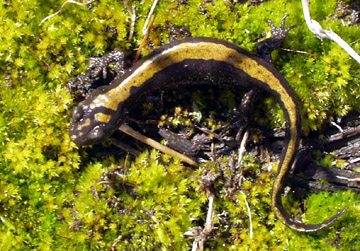Long-Toed Salamander
(Ambystoma macrodactylm)
 |
The long-toed salamander is one representative of
Waterton Lakes National Park's biological diversity.
The drama of the long-toed salamander began in Waterton
Lakes National Park when modifications were made to the road
running by the information centre. Due to their small size
(10 to 17 cm./ 4 to 7 in.) and nocturnal, burrowing
behaviour, salamander populations often go undetected.
Indeed, a large population of salamanders was only
discovered in Waterton Park when their migration to and from
Linnet Lake was interrupted by the construction of new curbs
and sidewalks along the road. In the fall of 1991 a park's
employee discovered several salamanders having difficulty
climbing the steep curbs, backing large numbers up on the
road. In 1992 many community volunteers turned up for about
a week in April, on cool rainy nights, to manually lift over
2,000 salamanders over the curb. |
This discovery led to testing and monitoring of several
alternatives by the warden service. In the end, the curbs
were replaced with rough, sloping,
"salamander-friendly" curbs and modifications to
water drainage. Salamanders now cross the road with a
minimal amount of difficulty. The incident emphasised the
need for a study of park salamander populations. Julie M.
Fukumoto of the University of Calgary agreed to conducted a
two-year study as part of her Master's Degree.
Julie found scattered isolated populations of long-toed
salamanders within Waterton Lakes National Park, similar to
study findings elsewhere in the province where the species
were listed as threatened. Some reasons identified for the
scattered, cut off populations of salamanders were -
- roadway mortality (long-toed salamanders require
both water and land habitats many of which are
intersected by roads);
- loss or alteration of habitat;
- past fish stocking practices (in lakes were fish
historically never existed, stocked fish eat many
salamanders and their eggs); and,
- global effects (amphibians are declining worldwide
perhaps due to the thinning of the ozone and
acidic precipitation).
In Waterton Lakes National Park, key issues identified for
future impacts on salamanders were -
- winter salting of park roads upsetting water
chemistry, which in turn effects aquatic life;
- occasional chlorine release from the Prince of
Wales hotel water tower affecting water quality in
Linnet lake; and,
- an increase in traffic during shoulder seasons
which may increase salamander mortality.
|
![]()
![]()
